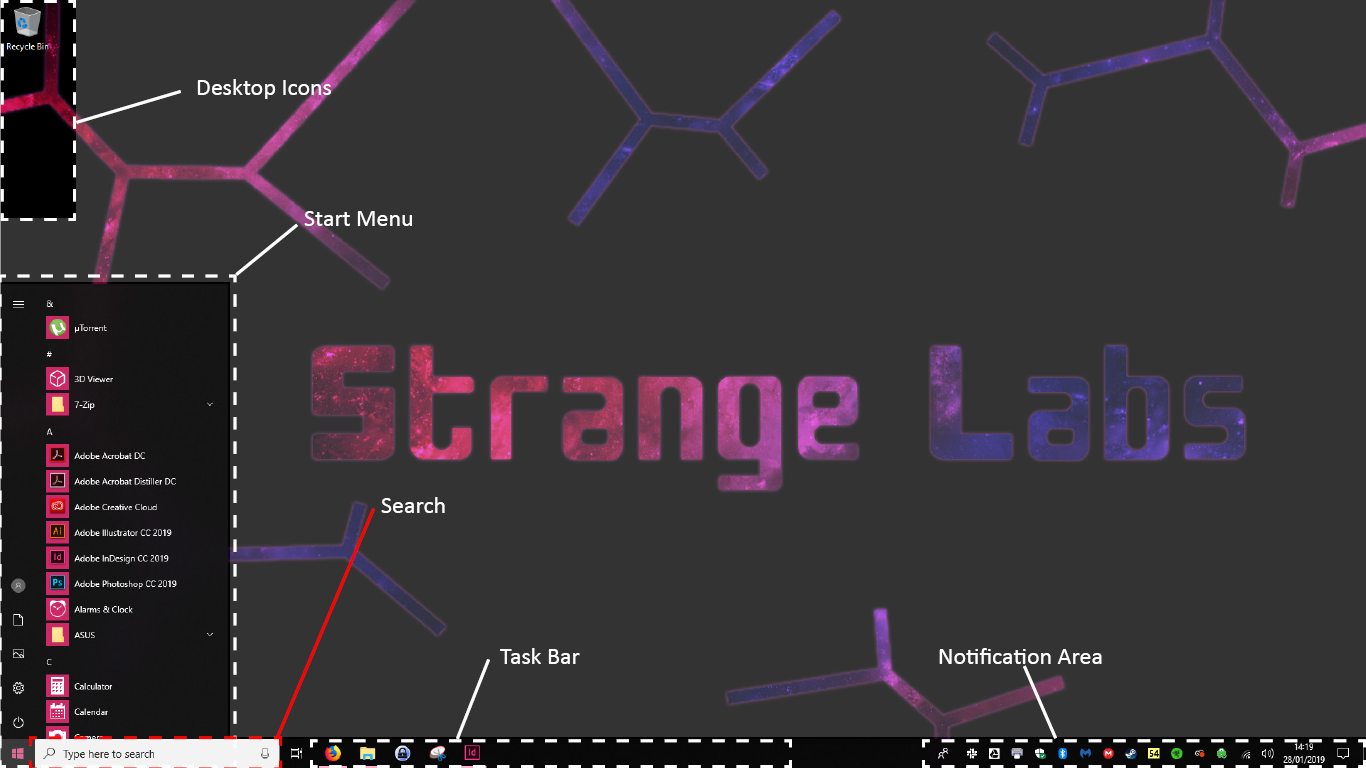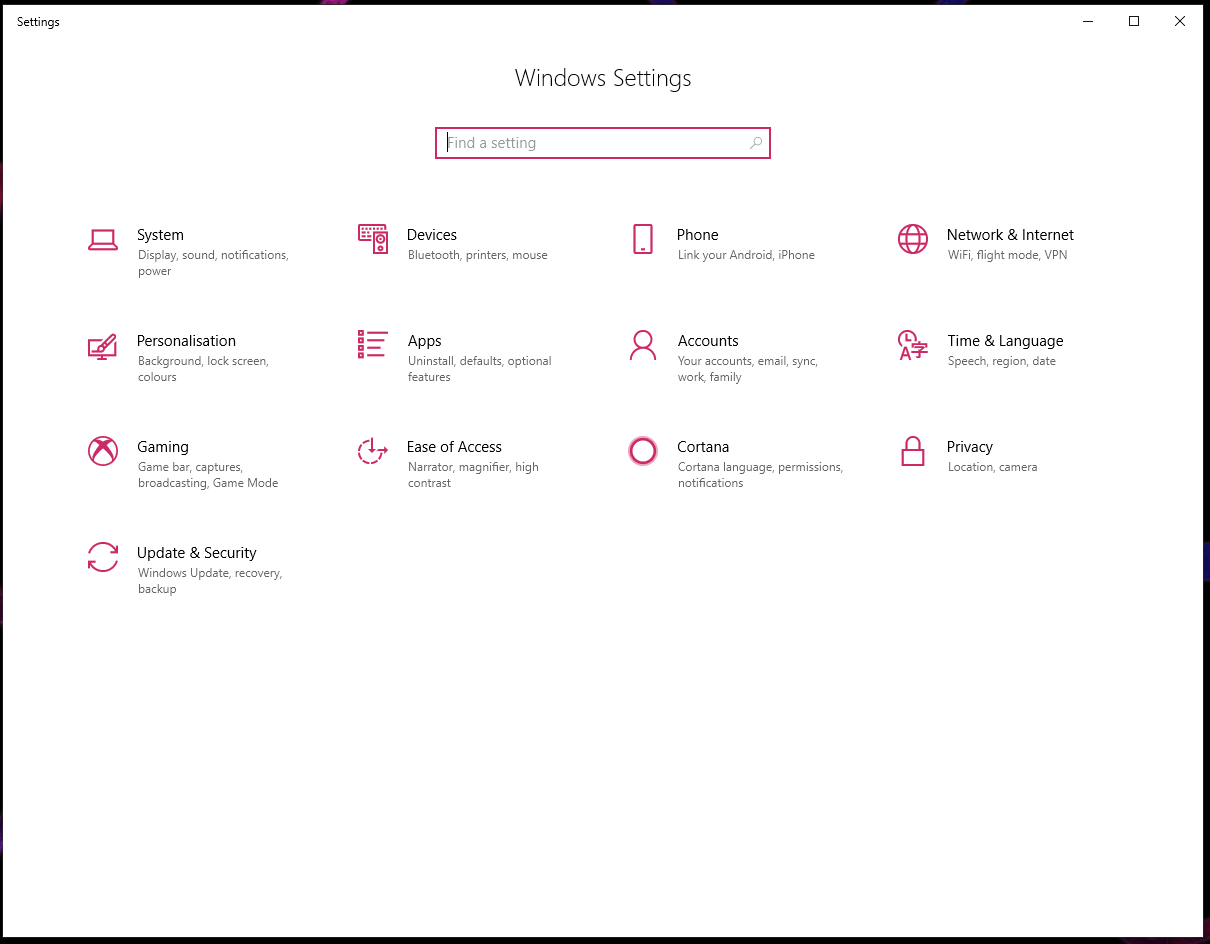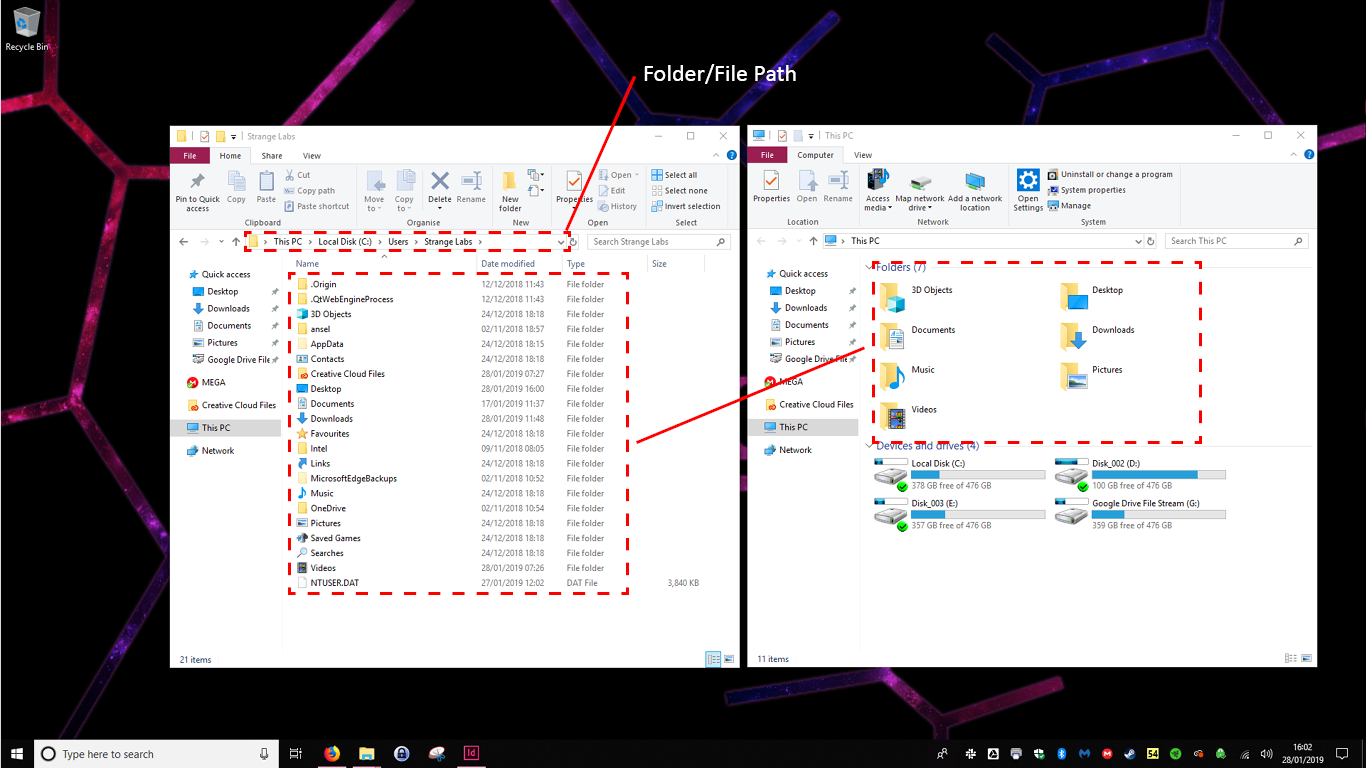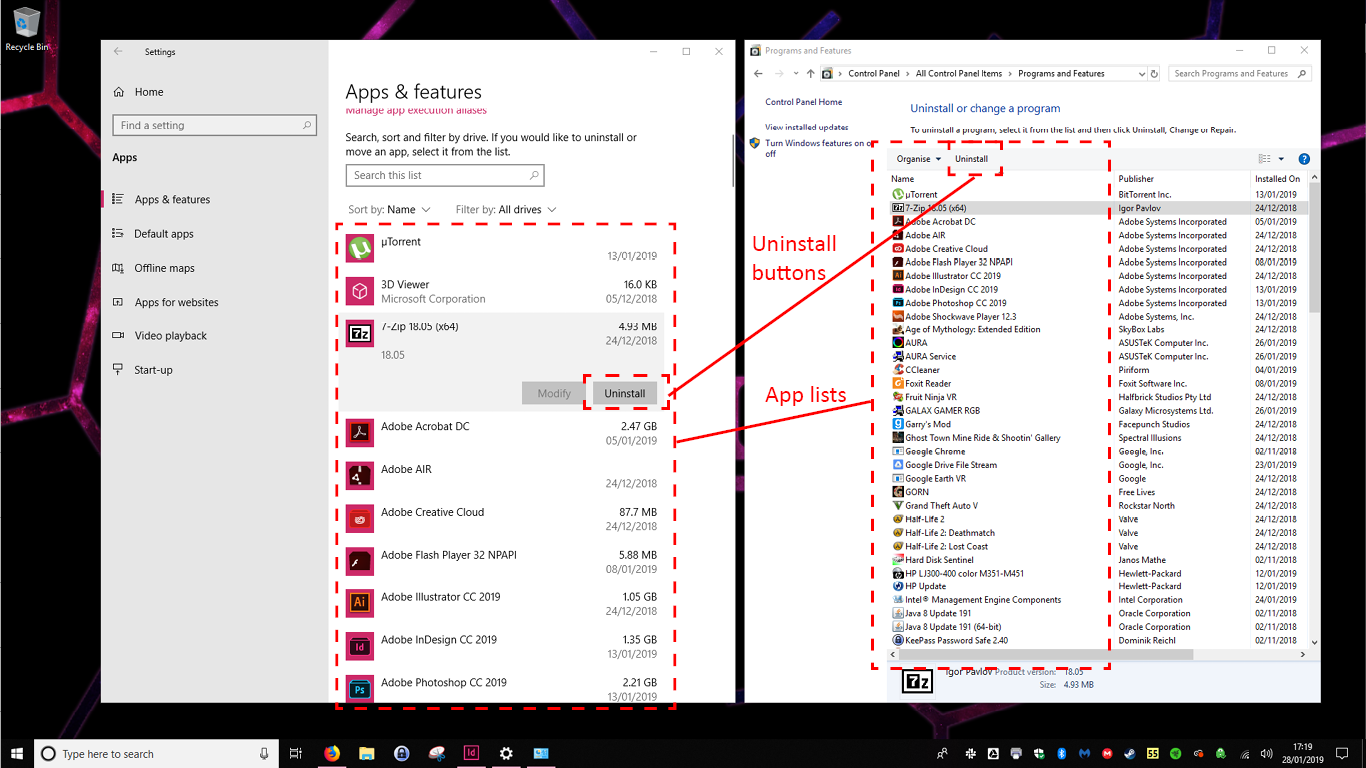Introduction
Many people have asked for help in getting started with Windows 10 and achieving a basic understanding of the operating system (OS). Although Windows 10 was released on July 29, 2015, some users still struggle to find their way around. This difficulty often stems from a less-than-ideal user experience rather than any fault of the users themselves. While a basic understanding of computers can be helpful, Windows 10 can be challenging due to its layered interface, which builds upon previous versions of Windows. To help our customers who have purchased machines from us, we’ve put together this guide to get you started with Windows 10, along with some general tips and tricks.
Find your way around
Screen Layout
Before diving into using your computer, let’s familiarise ourselves with the Desktop and Windows Explorer.[1].

You’re looking at the Desktop. It typically features a background image, a few icons, and a taskbar along the bottom. The Start Menu, accessible via the Windows icon at the bottom left of the taskbar, is where you find and launch applications. At Strange Labs, we remove all the default tiles usually found on the Start Menu (on the right of the application list) as they can be annoying. We also configure the Start Menu to only show the application list, without offering suggestions or recent documents. You can change those preferences in the Windows settings.
From left to right, the taskbar contains the Start Menu, Windows Search, Links (to apps or folders), currently open applications (Adobe Indesign in the above pictures case - the little line underneath the icon shows you that app is currently running) and then finally to the right is the notification area. This shows running apps, and apps which are running in the background. Sometimes, when you close an app, a little icon remains in the notification area. This means the app is still running but just not visibly.
Get into the habit of checking which apps are running along the bottom of your screen. If your computer slows down, it might be due to too many open applications. Closing unnecessary apps can help improve performance.
Search
If you can’t find something on your computer, use the search feature. Whether it’s an application, picture, or download, the search function will help you locate it. If a file has disappeared or you’ve moved it and can’t remember where, search for it before panicking. If the file is deleted, the search won’t find it, and you may need to contact us if it was important.
Settings

Let’s start your Windows experience by customising your system settings. This is a good practice as it often involves security and hardware settings that are unlikely to change frequently.
To access Settings, click the Start Menu (the Windows logo in the bottom left) and then the cog icon. Typically, cog or spanner icons represent settings.
There are many options in Settings, and it’s worth taking some time to go through each one to ensure everything is configured to your liking. We’ll cover a few key settings here.
Setting/ changing a password
You can find this option under “Accounts” > “Sign-in Options.” Here, you can set a PIN, set up Windows Hello (which allows you to log in through facial recognition), or link your local[2] account to a Microsoft online account. However, even with these additional options, you’ll still need a password, so make sure not to forget it! Personally, I recommend sticking to just a password.
Personalisation
If this is your computer, make it your own by personalising it to suit your taste. In the Personalisation section, you can change colours, the background image, and tweak the taskbar, Start Menu, and overall appearance of the OS. While not essential for functionality, personalising your computer can make it more comfortable and enjoyable to use.
Windows Update
Windows is notorious for its somewhat unreliable updating system. Updates often run in the background, and an untimely shutdown can cause issues. To avoid problems, periodically check for updates manually by going to “Update & Security” > “Windows Update” and clicking “Check for updates.” Watching updates as they install can give you peace of mind and help prevent unexpected problems.
Other settings
As mentioned, it’s a good idea to review all settings to ensure they’re configured to your preferences. For example, under “Apps,” you can set default applications (often better than Microsoft’s own) to open specific file types. The “Privacy” section allows you to adjust settings to prevent targeted advertising and other privacy concerns.
File Management
Now that you’ve customised your computer, let’s get a handle on how files and folders work. Everything on your computer is a file, and even applications are essentially collections of files. A Word document, for example, is a readable and writeable file, while an application file is executable.
Folders, on the other hand, are paths to files. The root[3] of your local Windows computer is usually the C: drive, which contains the Windows OS and all your files. For example, if you create a folder on the desktop, it would be located at C:/Users/YourUsername/Desktop/New Folder. Organising your files into folders is good practice to keep your computer tidy.

Home Folder
Your Home Folder contains the files you need to be concerned about, such as pictures, videos, documents, and downloads. The image above shows the contents of the Home Folder on the left, along with the same folders in the “Quick Access” section of File Explorer. These folders are the same, and this is where you should store all your files.
These folders have opened in what are called windows, (the namesake of the OS). Every rectangle you see on screen, whether it is a folder, or application, has opened in it’s own window.
Files you download from the internet, such as pictures, email attachments, and application installers, will by default go into your Downloads folder. It’s a good idea to regularly go through this folder and move files to the appropriate folders if you want to keep them. For example, move a downloaded movie to your Videos folder. If you don’t want a file, simply press “Del” with it selected to send it to the Recycle Bin.
If you use an app to organise and view files (e.g., Picasa for photos), the app will likely create or use folders in your Home Folder to store files. If you need to copy photos to a USB stick but can’t do it within the app, simply navigate to the relevant folder in your Home Folder to find them.
How To…
Copying, Pasting and Moving
There are two ways to transfer files from one location to another. The first method is to copy and paste, which is the default action when moving files between different drives[4]. To do this, highlight the files you want to duplicate, then either drag them from one window to another (if they’re on different drives) or right-click on the highlighted files and select “Copy.” Then, in the destination window, right-click again and select “Paste.”
If you drag files within the same drive, they’ll be moved rather than copied. The right-click[5] method for moving is called “Cut” and “Paste.” Understanding whether you’re moving or copying files will help you keep track of where your files are located.
Installing and Uninstalling Applications
A computer is useful for three main reasons: accessing the internet, storing and viewing data, and creating and manipulating data. To create and edit new types of data, you may need to install new applications. For example, you can’t open a .psd file with Microsoft Word; you’ll need Adobe Photoshop or another application that can read that file type.
On the other hand, it’s also important to uninstall redundant applications to free up space and prevent unnecessary background processes that slow down your computer. Many new computers, especially those from big-box stores, come pre-loaded with “bloatware” – unnecessary applications that you don’t need. Let’s cover uninstalling first.

Uninstalling Applications
Windows 10 offers two methods to uninstall applications, which can sometimes lead to confusion. Often, one method simply redirects you to the other.
To uninstall an app, click the Start Menu, then the Settings cog, and go to “Apps.” You’ll see a list of installed apps under “Apps & Features.” Click on the app you want to remove, then click “Uninstall.” Sometimes this works directly, but other times it will open a new window.
This new window is in the “Control Panel.” You can access it by clicking on Search in the taskbar and typing “Control Panel.” Then, go to “Programs and Features” to find a similar list of apps as in Settings. You might remember the Control Panel from earlier versions of Windows, as it was the main settings hub back then.
Installing Applications
Installing applications can be riskier than uninstalling them because it involves writing files to your drive. This is one way viruses can find their way onto your computer, so be careful about what you install. Most new software is downloaded from the internet (as CDs and other physical media are becoming less common). When you download software, you’ll usually get an “installer” – a .exe file that runs and writes the necessary files to your OS.
Make sure you’re downloading from a reputable source. As a general rule, only download installers from the official website of the software manufacturer.
To run the installer, double-click the .exe file. Follow the instructions in the window that opens, which will guide you through where and how to install the application. It’s generally best to stick with the default options provided by the installer (such as installing to C:/Program Files).
Before you click “Next,” “Continue,” or “Install,” double-check that there aren’t any extra checkboxes selected that allow additional software to install alongside your intended application. Programs like McAfee often try to sneak in this way.
Once the installation is complete, your program will be installed. You may need to restart your computer to finalise the process. You’ll find the newly installed program in both the Settings > Apps list and the Control Panel > Programs and Features list. You can launch the app from the Start Menu or any icons placed on the desktop or taskbar.
Conclusion
This guide should help you get started as a basic user and build the confidence to use your computer effectively. When in doubt, avoid uninstalling or deleting files you’re unsure about, but don’t be afraid to explore menus and try new things! And always remember to back up your data. For more tips on staying safe and managing your data, check out our other blog post How To Think In A World Of Cyber Crime.
Pro Tips
[1] Windows Explorer is an application that runs from the moment the OS loads, displaying the Desktop folder and providing a visual interface to explore your computer. Everything you see on screen is an application.
[2] Local refers to something that only affects your physical machine. A local account and password are stored on your physical, “local” machine. A Microsoft online account, however, is stored on Microsoft’s servers elsewhere in the world, so it’s not local.
[3] Root is the lowest-level directory in the file system.
[4] A drive is a component that allows you to access data. Examples include a hard disk drive (HDD), a solid-state drive (SSD), a USB flash drive, or cloud storage like Google Drive.
[5] The right-click is the menu click. Right-clicking on an item brings up a menu of available commands or options for that item.